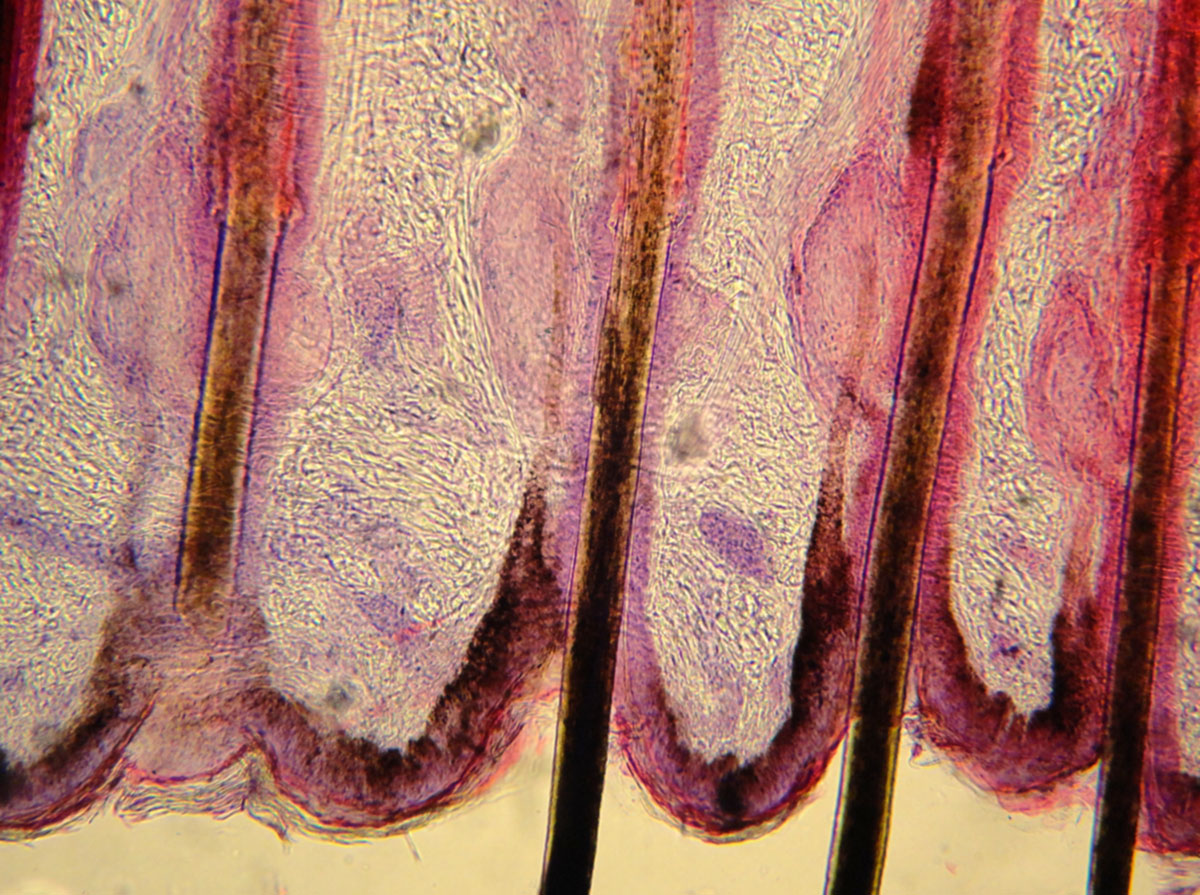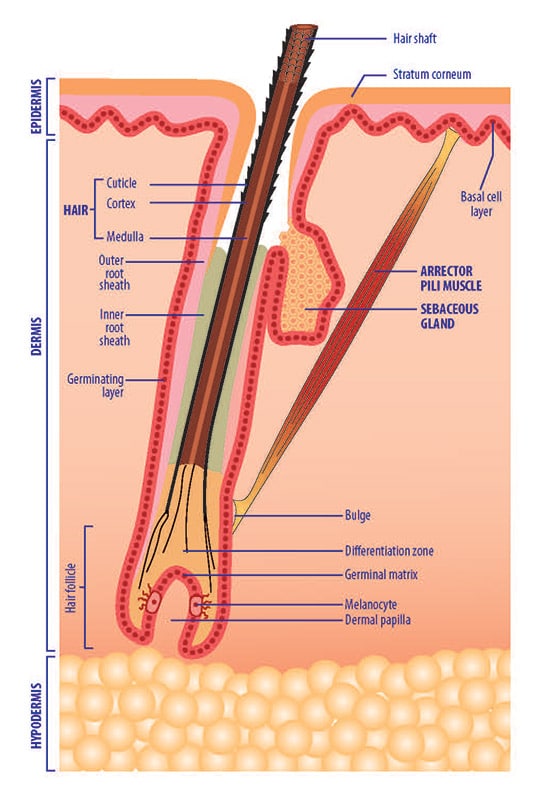Table Of Content

Follicles are small tube-like cavities in the epidermis in which individual hairs grow. They are present on all parts of the skin except the lips, palms of the hands, and soles of the feet. Certain types of folliculitis are known as hot tub rash and barber's itch. According to the American Academy of Dermatology, it’s completely normal to shed anywhere between 50 to 100 strands of hair per day. However, if you’ve noticed more strands falling out of your head than normal, you may be experiencing alopecia, the medical term for hair loss. Common diagnoses include androgenetic alopecia, alopecia areata, telogen effluvium, and lymphocytic scarring alopecia, Agbai tells USA TODAY.
Managing Recurring Scalp Folliculitis After Remission
Aureus lives on the skin and inside the nose, but it does not always cause an infection. However, an infection can develop on the scalp, or other parts of the body, if too much S. It's normal for someone to be concerned about their appearance if there are changes to the skin on their scalp or if there is hair loss. A head cover like a hat, scarf, or wig can cover the scalp while the hair grows back.
Causes of folliculitis

Small bumps, sometimes full of pus, can show up on your legs, especially your thighs. Your doctor may be able to diagnose folliculitis based on appearance alone. To identify the cause, they may remove or take a small sample of one of the bumps for testing. If you aren’t noticing any improvement after a few days, or things seem to be getting worse, make an appointment to see a doctor.
Things To Know about Vitamin C and Skin
If your immune system is weakened, you could see another type of folliculitis on your chest and neck, as well as your arms. Babies often get folliculitis on their chest and back, too. Sometimes a healthcare professional will drain a boil or carbuncle by making a small incision in the lesion to drain the pus.
A carbuncle is a cluster of boils painful, pus-filled bumps that form a connected area of infection under the skin. A lipoma is a non-cancerous) growth of fat cells that form a soft, movable lump under the skin. It develops when fat cells grow abnormally and clump together to form a lump beneath the skin.
One-Third of Black Women Will Experience Traction Alopecia—And the Cause Goes Beyond Tight Hairstyles - Well+Good
One-Third of Black Women Will Experience Traction Alopecia—And the Cause Goes Beyond Tight Hairstyles.
Posted: Thu, 24 Aug 2023 07:00:00 GMT [source]
It’s important to seek medical help if you get a rash, pimples, or boils that don’t resolve, or that reoccur. Early or ongoing treatment can help prevent complications. In this article, we explain why blocked hair follicles occur and how you can prevent and treat them. You can also consider alternative hair removal methods such as waxing, depilatories, or laser hair removal. When the hairs grow back, they’re typically finer, with a smooth tip instead of the blunt, rough tip that shaved hairs have, reducing instances of ingrown hairs. Folliculitis needs only symptomatic treatment in most cases, since the inflammation often clears up in a week or 10 days without any specific treatment.
A skin culture test may also be done to determine if the folliculitis is caused by a bacterial, fungal, or viral infection. During this test, a sample of the affected skin is obtained and sent to a laboratory for analysis. Chemical folliculitis can occur when harsh chemicals come into contact with the skin, leading to irritation and inflammation of the hair follicle. This can include chemicals found in hair dyes, lotions, and perfumes.

Treatment and Other Options for Permanent Scalp Changes
This is a test where a small sample of your skin is removed and then taken to a lab where it’s studied. It may look like acne or a rash and can be isolated to one hair follicle or affect many. It can be acute (occurring for a short time) or chronic (ongoing). Folliculitis is an inflammation or infection that can affect one or more hair follicles. Your hair follicles are the small cavities that surround the roots of your hair. Folliculitis is caused by damage to your hair follicles, which leaves them vulnerable to infection-causing bacteria and fungi.
Folliculitis Decalvans
It’s especially important to practice good vaginal hygiene during your period. Not only do hormonal shifts cause the skin to be more sensitive, but there’s also a higher population of bacteria that can infect hair follicles and chafed skin. Mild cases can be effectively treated with topical antibiotic lotions and creams. Never pick or pop an infected ingrown hair, as this also increases the risk of complications. A doctor may prescribe oral steroids, antibiotics, or other medications if the infection has a risk of becoming severe or spreading to the blood and internal organs.
Don’t dig for the hair, as this increases the risk of causing or spreading an infection. If simple measures over a few days do not allow the folliculitis to improve, you should probably see your GP for further advice and treatment. If there is an infection which is spreading deeper or onto surrounding skin you should see your GP. The affected skin can feel painful, hot and may be itchy. No, you can’t catch folliculitis decalvans from someone else.
Why does my hair hurt? Experts explain the strange but real sensation - Women's Health UK
Why does my hair hurt? Experts explain the strange but real sensation.
Posted: Thu, 29 Feb 2024 08:00:00 GMT [source]
If you get a rash after sitting in a hot tub, other people who sat in the tub are also likely to get it. Folliculitis is usually diagnosed during a physical exam with your healthcare provider. This can be done during an appointment and in most cases, you do not need to see a skincare specialist. Your primary care physician is usually able to diagnose folliculitis and provide a treatment plan.
There are 30 different types of Staphylococcus bacteria, but S. Overall, folliculitis is a common condition that can be bothersome and uncomfortable. While it’s generally not a serious medical issue, it’s important to seek treatment if the condition persists or shows signs of worsening. By understanding the causes, symptoms, and treatments for folliculitis, individuals can take proactive steps to manage their condition and avoid future recurrences.
The initially infected follicle may occur as a result of an ingrown hair, caused by a follicle blocked by sweat and dead skin cells. Genital folliculitis is more common in areas of the body where hair is rough and often shaved, including the vaginal region. There, the hair is coarser, the skin is more sensitive, and the risk of bacterial infection from razors or other hair removal products is higher. It may sound fancy, but folliculitis is pretty common and mostly harmless. Folliculitis is what happens when hair follicles become inflamed, usually as a result of a bacterial or fungal infection.
Washing with warm water and antibacterial soap is often enough to clean and help heal the area. You can also try a saltwater solution, or vinegar mixed with water. If none of these things does the trick, your doctor can prescribe an antibiotic you apply to your skin. See your doctor if it doesn't clear up within a couple of weeks, or if your symptoms are serious.. Most of the time, folliculitis clears up without any issues. Or you could notice that the skin in the affected area is lighter or darker than your usual skin tone.
At first it may look like small pimples around the tiny pockets from where each hair grows (hair follicles). Dirty hot tubs and spas can also cause folliculitis, as bacteria thrive in inadequately chlorinated warm water. Make sure to clean in between your legs and around your vagina thoroughly after sex and after using a hot tub to reduce your chances of infected hair follicles. You may also experience higher occurrences of vulvar folliculitis during your period due to the shifts in hormone levels. In most cases, the main symptom of folliculitis is red bumps that look like pimples on your skin. These could also look like they’re white-filled bumps or they could be filled with pus (pustules).
A non-infective type of folliculitis occurs because of regrowth of hairs after hair removal, by plucking, electrolysis or shaving. Scalp infections are caused by bacteria or fungi that enter the hair follicles or skin of the scalp. Having a scalp infection can lead to various types of skin rashes on the scalp as well as hair loss. When hair follicles become infected or inflamed they swell causing a red bump on the skin. Sometimes the affected follicles fill with pus, covering the affected skin with small, rounded, yellow-red spots (pustules). Affected skin may develop a crust, which can be yellow or golden coloured due to infection.

No comments:
Post a Comment